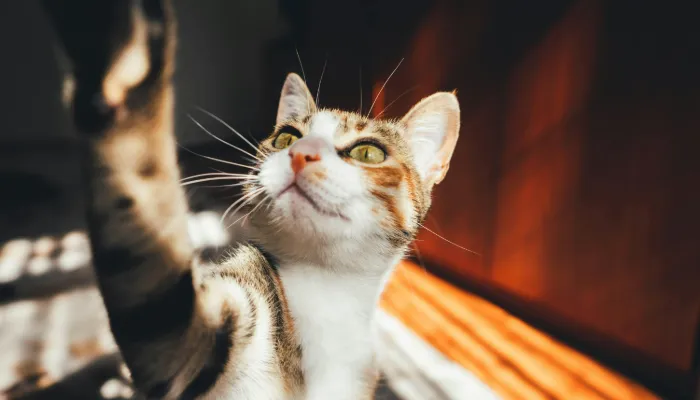Cats are agile, self-sufficient, and intelligent animals. Unlike dogs – which are more emotional – cats speak a different language through body structure, sounds, and even actions. This raises the question amongst pet lovers out there – Are Human to Cat Translators Real? Is it possible to communicate with cats through advanced technology and vice-versa?
In this article, we will delve into the existence of cat translators, the science behind feline communication, as well as evidence from science regarding translating cat sounds to human language.

How Do Cats Communicate?
To better understand the question, are human to cat translators real? we need to first look at how the cat expresses themselves towards human beings as well as other animals. Unlike humans whose predominant method of communicating is speech, cats utilize sounds, body movements, and faces to get their message across.
1. Sounds
Cats produce various sounds to convey feelings which include the following:
- Meow Calling: This is used primarily to communicate with humans rather than other cats.
- Purring: Though this is usually gentle and a sign of happiness, a cat may sometimes purr to soothe itself when in distress.
- Hissing/Growling: This may indicate fear, growing rage, or discomfort.
- Chirping/Trilling: A friendly way of saying hi, or a request for your attention.
2. Body Language
Cats often convey their feelings through the positioning of their ears, the posture of their bodies, and the movement of their tails.
| Body Part | What It Means |
|---|---|
| Tail Up | Happy, confident |
| Tail Twitching | Excited or irritated |
| Flattened Ears | Fearful or defensive |
| Slow Blinking | Affection and trust |
| Arched Back | Defensive or playful |
3. Scent Marking
Cats use scent as a way of communication and marking their territory. When a cat rubs their face on you or furniture, they are transferring their scent and claiming it as theirs.
These simple mechanisms of communication can give us an idea of how effective a human-to-cat translator could actually be.
Effectiveness of Human to Cat Translators
With growing technology, there are a number of apps and gadgets that claim to translate cat sounds into human words. These devices record meows and try to interpret them using a catalog of pre-recorded sounds. But how reliable are they?
1. How Do Cat Translator Apps Work?
Most cat translator apps work based on machine learning and pattern recognition. They take a cat’s meow and store it in a library of known cat sounds and suggest a possible meaning.
Some apps even allow users to record their voice and “translate” it to meows to talk back to their cats.
Cat translator apps that are known include:
- MeowTalk
- Human to Cat Translator
- Cat Language Translator
2. The Science Behind Cat Translation
While there is technology that claims to utilize devices such as cat translation software on smartphones, scientific studies on cat translation are still quite limited. Some studies show cats having individualized sounds for their owners, but overall there is no clear defined cat language that you could translate like human languages.
3. Do Experts Believe in Cat Translators?
Most animal behaviorists are well aware that cat translator apps exist, and while they could be used for entertainment purposes, they should not be trusted for proper communication. Instead, understanding your own cat and familiarizing yourself with its sounds and behaviors is the best way to understand them.
Thus, while apps could offer an insight into how a cat expresses itself, the answer to Are Human to Cat Translators Real? is not yet clear from a scientific standpoint.
Pros and Cons of Cat Translator Apps
These applications do come with their pros and limitations, one being the ability to meow a phrase and receive it in human language.
Advantages
- Gives a playful spirit to the owners.
- Works well to improve the attention given to the cat’s sounds.
- Some applications provide details on elementary cat sound patterns.
Downside
- There is no valid evidence to support that meows are translated correctly.
- Different cats have different voice boxes, thereby making translation complex.
- May lead to misguided reasoning regarding a person’s comprehension of a cat’s feelings.
So, Are Human to Cat Translators Real? To some extent, yes but the real question that needs to be addressed is how accurate and reliable they are.
The Future of Human-to-Cat Communication
There is a possibility, with progress in technology and animal psychology, cat translators can be more precise in the future. The way researchers are looking at how humans and cats interact is quite promising and can be equipped with advanced technology in the future.
1. Machine Learning and Artificial Intelligence
Novel AI frameworks can scan a broader scope of cat gibberish, heightening the chances of accurate translation.
2. English to Cat Language Translators for Cats
Collars integrated with the capability to instantaneously detect and translate a cat’s sounds could also be possible in the future.
3. Personalized Cat Communication Tools
It is a long-term process but Cats’ communication is profoundly different than human communication and requires much more research in order to be technologically accurate.
Conclusion
So, Are Human to Cat Translators Real? The answer is yes, there are numerous apps that claim to help cats communicate with humans but none of them are scientifically accurate.
Felines articulate themselves through meowing, body movement, and scent marking. All of which cannot be explicitly defined with human speech.
To form a bond with your cat, you will need to show understanding. Although cat translators can be fun, effective communication with your pet stems from a strong bond built on trust.
Would you download a cat translator app or would you rather receive a deeper appreciation for your pet by learning their language yourself? Tell us yours in the comments!
